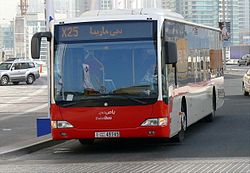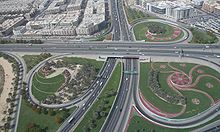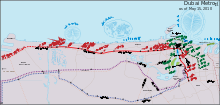- Transportation in Dubai
-
 An RTA Mercedes-Benz Citaro
An RTA Mercedes-Benz Citaro
Dubai's Roads and Transport Authority (RTA) regulates transportation within the city of Dubai, U.A.E.. Initially started as Dubai transport in 1998, the government of Dubai revamped the system to unify it's services under the brand name "RTA" in 2006, in order to accommodate the metro and other facilities under one name.
Contents
Roads
Dubai has a very large bus system run by the Roads and Transport Authority (RTA). The bus system has 193 routes on weekdays and transports over 30 million people weekly[citation needed]. The Public Transport bus system is large and advanced but not large enough to accommodate the volume of people who use it. This means that in busy areas it is common that at the end of the day commuters may have to wait more than an hour before they can board a bus. Unfortunately the number of buses does not increase with the same rate as the amount of passengers, which makes this problem worse as time progresses.
The (RTA) has announced that Dubai roads will see 1616 new buses; a world record bus purchase. The buses will be of various sizes & models manufactured at the highest security & safety standards. The buses are equipped with the latest technologies such as voice announcement of the next stop, passengers counting system, bus-positioning system linked with the RTA Control Center, and internal & external display monitors. The new fleet is expected to be fully operational by the end of 2008.[1]
Dubai also has an extensive taxi system, by far the most frequently used means of public transport within the Emirate. There are both government-operated and private cab companies. The Dubai Transport Corporation operates cream-coloured taxis. Some of the private cab companies are Cars Taxi, National Taxi, Cititaxi and Metro Taxi. The meter generally begins as Dhs . 3.00' and is generally charged by distance at 1.5 Dhs./km. There are approximately 7500 taxis located in the city.
Because of the growing population, commuters in Dubai experience a high amount of traffic congestion. The city has become the most congested city in the Middle East. Professionals working in Dubai spend an average of 1 hour and 45 minutes commuting to and from work. The government has invested heavily in the Dubai's road infrastructure, although this has not kept pace with the increase in the number of vehicles. This, coupled with the induced traffic phenomenon, has led to growing problems of congestion.[2] However, as of May 2009, with thousands of expatriate workers having lost their jobs and left back to their countries following the economic crisis, traffic congestion has eased significantly.
Traffic congestion, the single biggest concern among Dubai's 1.44 million residents, inflicts losses of Dh4.6 billion or 3.15% of the emirate's Dh146 billion GDP a year. The city has a car ownership rate of 541 cars per 1,000 population. This figure exceeds that of cities like New York City [444 cars per 1,000 population], London [345 cars per 1,000 population] and Singapore [111 cars per 1,000 population]. If this trend continues, then by 2020, there will be 5.3 million registered cars in Dubai.[3]
According to some traffic experts, Dubai is suffering from an originally flawed road system, with in-built bottlenecks on certain key routes such as the Dubai-Sharjah road. Over time, however, the new infrastructure including the Dubai Metro, the new bridges and complex of flyovers is expected to ease congestion to some extent.[2]
A further 500 km of roads plus 120 multi-level interchanges will also be built before 2020 at a cost of around 44 billion dirhams ($12 billion) as transport chiefs in the emirate aim to improve life for motorists.[4]
Metro
Main article: Dubai MetroThere is currently a $3.89 billion Dubai Metro project under construction for the emirate. The Metro system is expected to be partially operational by 2009 and fully operational by 2012. The construction contract for the project was given to Dubai Rapid Link (DURL),[5] a consortium led by Mitsubishi Heavy Industries. Also involved are two other Japanese corporations, Obayashi and Kajima, and a Turkish company, Yapi Merkezi. The metro will comprise two lines: the Green Line from Rashidiya to the main city center and the Red Line from the airport to Jebel Ali. The Dubai Metro (Green and Blue Lines) will have 70 kilometers of track and 43 stations, 33 above ground and ten underground. Trains are expected to run every 90 seconds when the project is completed. Recently, the Blue Line connecting Dubai International Airport to the new Jebel Ali Port and Dubai World Central International Airport was announced. The route will run 47 km through Dubailand, but the exact number of stations is unknown. Dubai is building this train system to ease congestion on its road network and to meet the transportation demands of its growing population.
Seven monorails are also slated to be constructed to help feed the Dubai Metro, connecting various places such as Dubailand, the Palm Jumeirah and other districts the main track. The first of these, the Palm Jumeirah Monorail, is scheduled to open in April 2009, although the extension to the Dubai Metro is expected to open later. there is a six road motorway from the airport
Trams
Main article: Downtown Burj Dubai TramwayAs of April 2008, there were two expected trams to be built in Dubai by 2011. The first is the Downtown Burj Dubai Tram System and the second is the Al Sufouh Tramway.
The Downtown Burj Dubai Tram System is a 4.6 km (2.9 mi) tram service that is planned to service the area around the Burj Khalifa.[6] Announced in April 2008 by Emaar, the Dh500 million system will have two separate lines. The first line, which is expected to open by the end of 2009, will run 1.1 kilometres (0.68 mi) from Dubai Metro's Burj Khalifa station to the Dubai Mall with one stop at the Dubai Mall Hotel. While this line will have trams running in both directions, the second line will only run in one direction. The second phase, expected to open in 2010, will service ten stations. The 4.6 km loop will travel clockwise and will have a total travel time of eight minutes.[7]
In the same month, the Dubai Roads and Transport Authority announced the Al Sufouh Tram. This tram service would run 14.5 kilometres (9.0 mi) along Al Sufouh Road from Dubai Marina to the Burj Al Arab and the Mall of the Emirates. It is expected to connect with three stations of Dubai Metro's Red Line. Phase 1, expected to open in April 2011, will have 11 trains with 13 stations running 10 km (6.2 mi). Once Phase 2 is complete, the tram will add 14 more trains and six stations on the additional 4 km (2.5 mi). The planning and construction of the Al Sufouh Tram will be undertaken by a consortium of Alstom, Besix and Parsons.[8][9][10][11]
The trams for the network will be 44 m (144 ft) long, have a capacity of 300 passengers and will travel at a maximum speed of 50 km/h (31 mph) and an average commercial speed of 20 km/h (12 mph). Running for 20 hours each day, it will only take around 30 minutes to ride the entire length of the system. The Al Sufouh Tram will use Alstrom's Citadis 402. To provide safety, comfort and aesthetics, the Al Sufouh Tram will incorporate methods not found in many trams around the world. These trams will use ground-level power supply; in other words, the trams will not need overhead cables. This recently-invented method, referred to also as "Aesthetic Power Supply" (APS), is currently only used in Bordeaux, France. The Al Sufouh Tram will also be the world’s first tram network to use platform screen doors at the stations, as well as a new Supervised Vehicle Operation (SVO) mode that will ensure accurate station stop and safety during passenger transfer.[8][9][10][11]
In June 2010, the consortium led by France’s Alstom and the local/Belgian Belhasa Six Construct stopped work on the estimated $1.1bn Al-Sufouh tram project in Dubai because of irregular payments from the project client, Dubai’s Roads & Transport Authority (RTA). The original completion date of April 2011 has also been extended.[12]
Ports and water travel
 Water Transport (Abra), Bur Dubai
Water Transport (Abra), Bur Dubai
Dubai is serviced by two large commercial ports, Port Rashid and Port Jebel Ali. Dubai Creek and Port Saeed are used by local traders in dhows.
One of the more traditional methods of getting across Dubai Creek from Bur Dubai to Deira is through abras, small boats that ferry passengers across the Dubai Creek, between abra stations in Bastakiya and Bani Yas Road, for a nominal charge of 1 UAE-Dirhams. They can be rented, along with an operator, for 100 UAE-Dirhams, approximately 27 US-Dollars. Recently, the Marine Transport Agency, part of the Road and Transportation Agency, has begun implementing the Dubai Water Bus System. The Water Bus began its service on Dubai Creek's water from July 2007.
Air travel
 Interior of the passenger terminal at Dubai International Airport
Interior of the passenger terminal at Dubai International Airport
The Dubai International Airport is a hub for Emirates and FlyDubai and has a large duty-free shopping centre. The airport has won numerous awards for its excellence in design and services [13]. A third terminal was opened in October 2008. The new terminal is dedicated to Emirates Airlines and fully supports the new Airbus A380. The completion of this terminal doubled the capacity of the airport.
Al Maktoum International Airport, currently under construction, will make a new free trade area within Dubai and will be the centerpiece of the Jebel Ali Airport City. The airport was announced in 2004 and construction began in January 2005. The first part is expected to be completed by 2008. Although initially intended as a predominantly cargo airport, plans are afoot for the new Jebel Ali airport to handle some 120 million passengers per annum within 20 years, which would likely surpass Atlanta's Hartsfield-Jackson International Airport, as the world's busiest airport.[14]
Dubai is investing heavily in developing the reach of its airline, Emirates. The hope is to develop Dubai's air transportation industry to the point that passengers from any city can fly direct to Dubai. When Emirates Airline receives the Boeing 777-200LR aircraft—part of its November 2005 order for forty-two 777s—it will be able to offer direct flights to nearly any major city in the world. The airline has also placed an order of 45 of Airbus' A380 'superjumbo' double decker aircraft, the largest of which has a capacity of 641 passengers. The A380 aircraft have already been charted to fly from late 2007 onwards.
In addition Etihad Airways provides bus coaches between Dubai and Abu Dhabi International Airport for Etihad customers.[15]
See also
- List of roads in Dubai
References
- ^ "Dubai News Online" article
- ^ a b Dubai Overtakes Cairo in Traffic Congestion - GulfTalent.com
- ^ Gulfnews: Dubai traffic woes inflict losses of Dh4.6b a year
- ^ "Bus lanes, cycle zones part of $12bn traffic master plan". ArabianBusiness.com. 2008-11-25. http://www.arabianbusiness.com/539418-bus-lanes-cycle-zones-part-of-12bn-traffic-master-plan. Retrieved 2008-11-25.
- ^ Dubai Municipality signs Dhs12.45 billion Metro contract, Dubai Metro, May 29, 2005
- ^ "Burj Dubai tram plan unveiled". Railway Gazette International. 2008-04-24. http://www.railwaygazette.com/news/single-view/view/10/burj-dubai-tram-plan-unveiled.html. Retrieved 2008-05-03.
- ^ "Emaar unveils advanced public tram system for Downtown Burj Dubai". Gulf News. 2008-04-23. http://archive.gulfnews.com/articles/08/04/23/10207900.html. Retrieved 2008-05-03.
- ^ a b "Smooth ride for Jumeirah residents". Gulf News. 2008-04-30. http://archive.gulfnews.com/articles/08/04/30/10209520.html. Retrieved 2008-05-03.
- ^ a b "Tram will be ride on time". 7Days. 2008-04-30. http://www.7days.ae/en/2008/04/30/tram-will-be-ride-on-time.html. Retrieved 2008-05-03.
- ^ a b "H.H Sheikh Mohammed bin Rashid approves the design of the AED 4b Al Safooh Tram project". Dubai & Roads and Transport Authority. 2008-04-29. http://www.rta.ae/wpsv5/wps/portal/!ut/p/kcxml/04_Sj9SPykssy0xPLMnMz0vM0Y_QjzKLN4g3NjEGSUGYRvqRaGKOCJEgfW99X4_83FT9AP2C3NCIckdHRQA1RSz5/delta/base64xml/L3dJdyEvd0ZNQUFzQUMvNElVRS82XzBfMzRI?contenttype=latest&contname=H.H%20Sheikh%20Mohammed%20bin%20Rashid%20approves%20the%20design%20of%20the%20AED%204b%20Al%20Safooh%20Tram%20project. Retrieved 2008-05-03.
- ^ a b "Al Safouh tram project consortium selected". Railway Gazette International. 2008-04-29. http://www.railwaygazette.com/news/single-view/view/10/al-safouh-tram-project-consortium-selected.html. Retrieved 2008-05-03.
- ^ "Consortium stops work on Al-Sufouh tram". MEED. 2010-06-09. http://www.meed.com/sectors/transport/rail/consortium-stops-work-on-al-sufouh-tram/3007054.article. Retrieved 2010-06-09.
- ^ Skytrax - Best Airports Middle East
- ^ Jebel Ali Airport Jebel Ali Airport
- ^ Dubai." Etihad Airways. Retrieved on 6 February 2009.
External links
- MEED - Middle East Business intelligence since 1957: "Middle East business news and analysis, tenders, contracts awarded, commentary, economic data, insight, projects and events" - magazine website
Bridges and tunnels in Dubai Developments in Dubai Skyscrapers Shopping centres Entertainment Transport Land reclamation Other projects List of development projects in Dubai • List of tallest buildings in DubaiCategories:- Transport in Dubai
Wikimedia Foundation. 2010.



